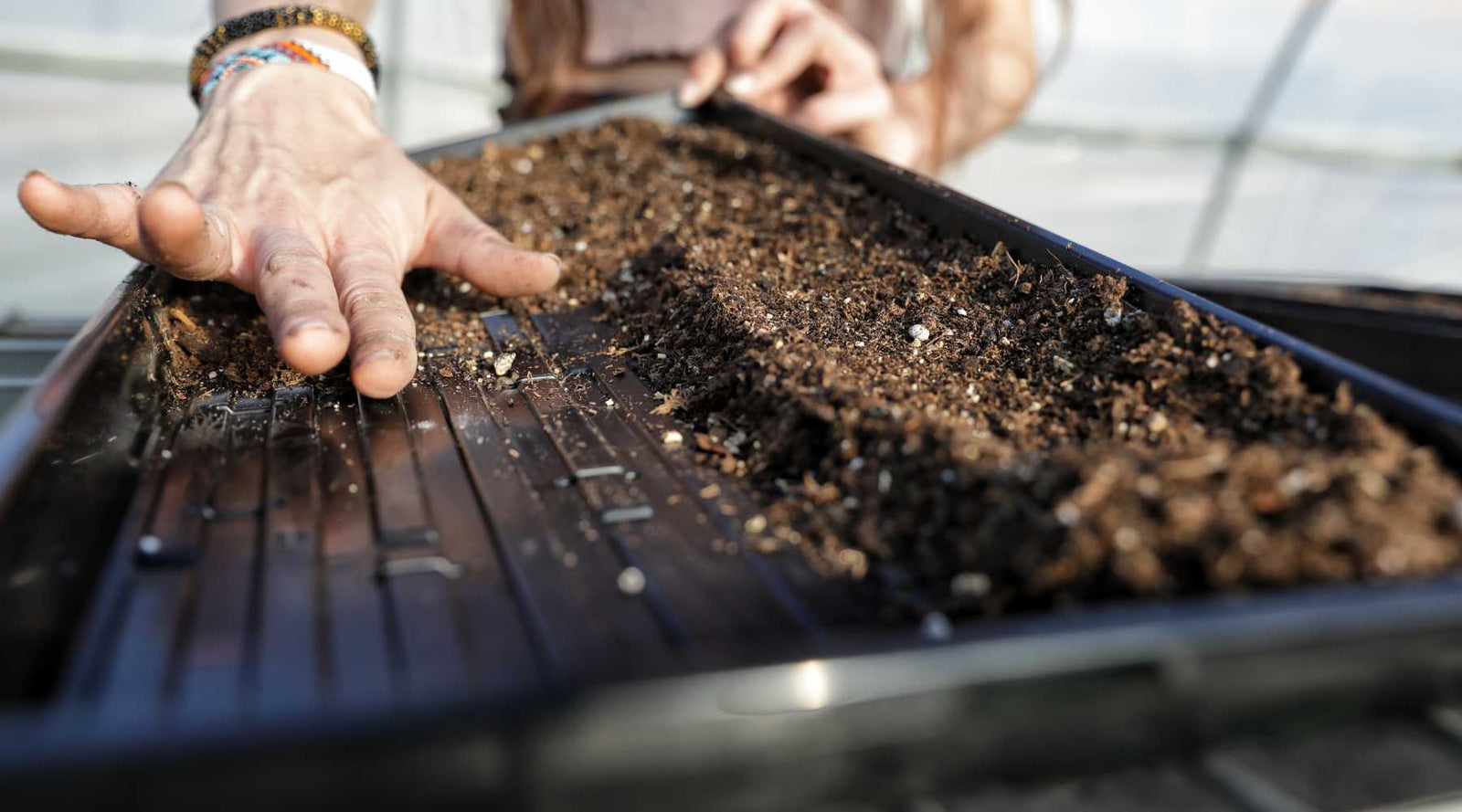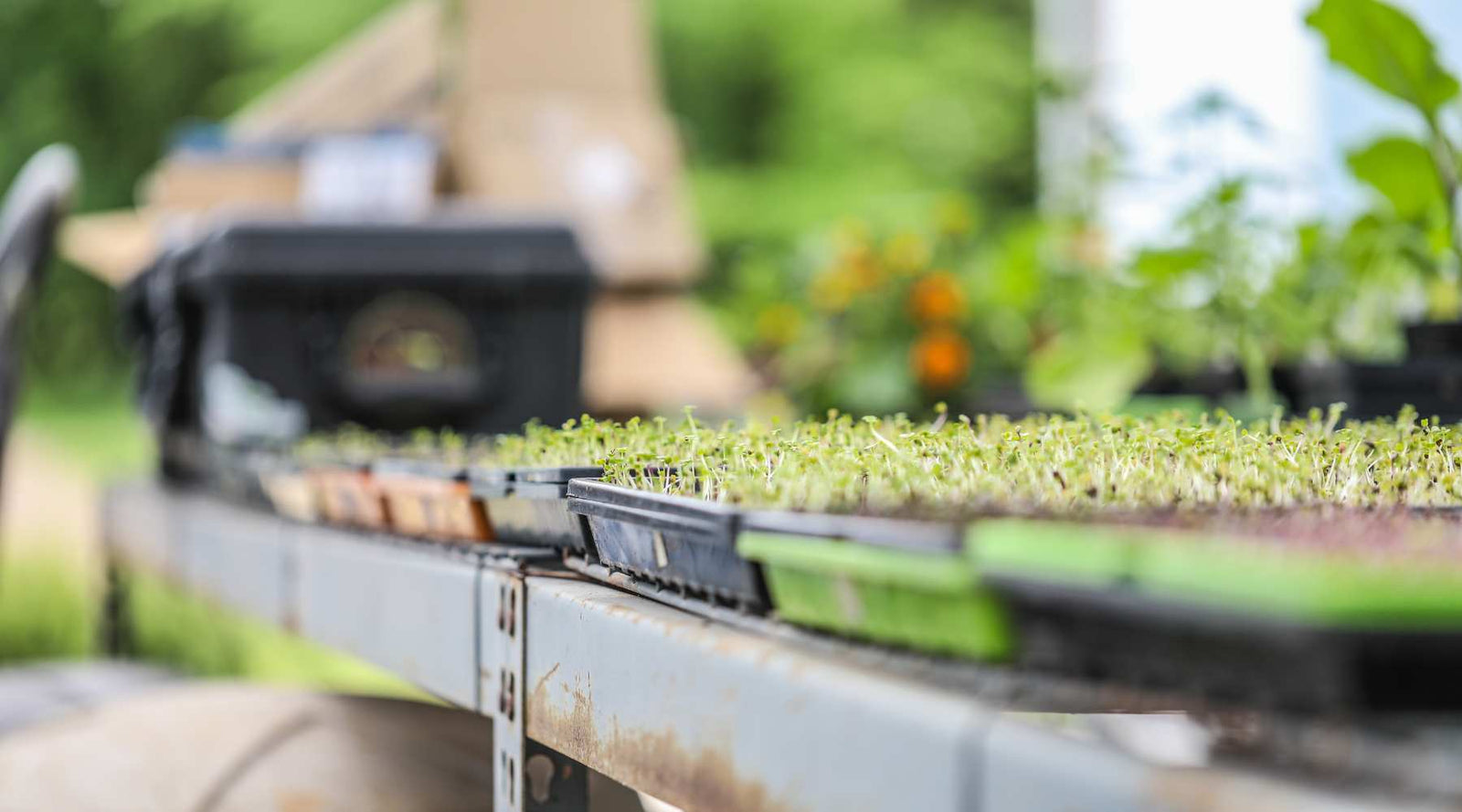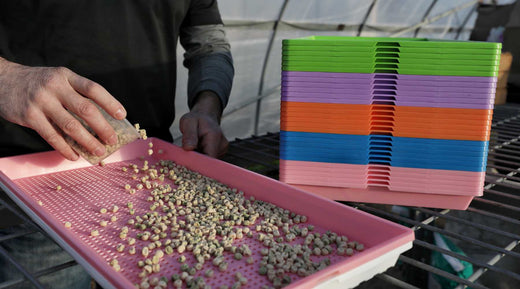20% Off USA-Made All-Metal Greenhouse Kits until May 31
20% Off USA-Made All-Metal Greenhouse Kits until May 31
6 Common Microgreen Problems and How to Solve Them
July 29, 2024 3 min read 0 Comments

Why are my microgreens not growing?
6 Reasons Why Microgreens Fail
- Uneven seeding
- Low germination rate from seeds
- Mold growth/damping off
- For larger seeds, improper soak time
- Uneven watering
- Bad seed lot from the seed supplier

Uneven Seeding of Microgreens Trays
This problem usually results from one of two reasons.
- Uneven planting surface
The first step is to ensure that your planting surface is even and well tamped down. Fill your tray with the desired amount of growing media. Smooth it as evenly as possible with your hand. At the same time, you are using another flat bottom tray or cut board to tamp the media firmly BEFORE you water. I like to use a mesh tray for tamping down. It presses the surface evenly without compressing it too much.
- Improper seeding rate
Use the proper seeding rate for your tray size. Weigh or measure your seeds before you spread them out. Check out the Ultimate Microgreen Growing Resource for suggested seeding rates. To save a little time, you can weigh out a type of seed and then get the volume needed, so you don’t have to weigh every time.
**For example, 30 grams of my radish seed mix is just about three tablespoons. Every time I get a new batch of seeds, I weigh to get an accurate volume.
Low Germination Rate of Seeds
Low germination rate from seeds can be a problem that takes a little work to diagnose.
- Buy high-quality seeds for optimal germination.
When purchasing seeds, check the germination rate in the seed description. Growing microgreens from any seed lot with less than a 75% germination rate is not recommended.
- Older seeds can have a lower germination rate than new seeds.
To run a germination test on your seeds, place 10 to 20 seeds in a wet paper towel and let them sprout to check their vitality. If only 14 out of the 20 seeds germinate, your germination rate is 70% and too old to be used for microgreens.
Want to learn more about what variety of microgreens to grow? Read Top 10 Microgreens to Grow.
Mold Growth on Microgreens and Seed Soaking
Mold growth, damping off and improper soak time are all related problems.
The two leading causes of mold growth and damping off are lack of airflow and “dirty” seeds. Learn more about combatting mold here.
Ensure your growing space has adequate airflow by installing fans in your grow room. Humidity can also be an issue, so, depending on where you live, using an air conditioner or dehumidifier can work wonders. I like to keep my grow room between 65 and 80 degrees Fahrenheit. A room kept cooler than that can cause the plants to grow too slowly. Higher than that, the chances of mold increase dramatically.
Some crops are more prone to mold than others. Larger seeds are the usual culprits. They are more likely to be “dirty” because they have a greater surface area to hold mold spores. They are also the seeds that we soak before planting.
This resource here is our cheat sheet, which also shows recommended soak times. Always use the lowest soak time to start as you figure out what works best for you. Sterilizing some crops is the best way to prevent mold and damping off.
Related | Learn How to Grow Microgreens at Home | A Step by Step Guide

Uneven Watering of Microgreens
- If stacking, thoroughly water those trays with a gentle mist and DO NOT TOUCH them for at least a few days. No peeking under the trays! That seed is sticky from being wet and will stick to those trays until it has some growth anchoring it to the soil. The mist will keep the seeds from being moved around by the water.
Proper bottom watering, if all of your seeds are not staying saturated, you may have sporadic germination. Make sure your surface is level, and you are adding enough water to reach all corners of the tray.
Check out How to Water Microgreen Trays | Which Method is Best? for more information on watering microgreens.
Also in Microgreens Guides & Resources

How to Market Microgreens: Strategies That Get Results
March 27, 2025 13 min read 0 Comments
In this article, we’ll help you stay at the top of your microgreen game to help you succeed in this exciting venture.

Must-Know Tips for Edible Flower Farming Success
February 05, 2025 9 min read 0 Comments
Learn how to expand your markets, what popular edible flowers to offer, marketing tips, new trends, and best practices.

What Lights Do I Need to Grow Microgreens?
January 13, 2025 10 min read 0 Comments
Recent Articles
- How to Market Microgreens: Strategies That Get Results
- Must-Know Tips for Edible Flower Farming Success
- What Lights Do I Need to Grow Microgreens?
- How To Grow Microgreens Indoors - SEED to HARVEST
- A Quick Guide to Starting a Microgreens Business
- How and When to Use 10x10 Microgreen Trays to Grow Nutrient-Packed Greens
- How to Disinfect Seeds Before Planting and Sprouting
- Top 5 Best Growing Mediums for Microgreens
- What Trays Do You Need for Microgreens and Propagation?
- Top Ten Microgreens to Grow
Subscribe
Sign up to get the latest on sales, new releases and more …
